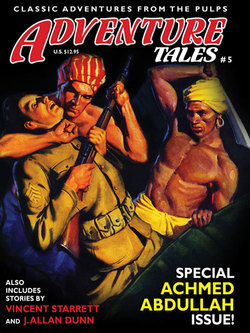Читать книгу Adventure Tales #5 - Vincent 1886-1974 Starrett - Страница 3
На сайте Литреса книга снята с продажи.
ОглавлениеTHE BLOTTER, by John Gregory Betancourt
Meet Achmed Abdullah!
I’m not sure when I first became aware of the works of Achmed Abdullah. It must have been in the early 1980s, when I first began collecting pulp magazines, and spotted this curious Arab-sounding byline in issues of Adventure. I rapidly became a fan: this Abdullah fellow could write!
Many of his stories deal with exotic locales, usually Oriental. But even his Occidental tales are of interest, well written and fast paced, often with an unexpected twist or two. I began gathering his stories whenever I spotten them, and the result was one of Wildside Press’s first original collections of pulp stories: Fear and Other Tales from the Pulps, by Achmed Abdullah…the first new collection of his work in more than 50 years. (Needless to say, I recommend it highly.)
I could go on about him, but Darrell Schweitzer’s scholarship on Achmed Abdullah far exceeds by own, so I will simply quote part of his introduction to Fear:
* * * *
Those who met Abdullah found him very British in speech, manner and ideas. Indeed, he had been educated at Eton and Oxford (and the University of Paris), and had served in the British Army in the Middle East, India, and China, but he was actually the son of a Russian Grand Duke, the second cousin of Czar Nicholas II. His Russian name was Alexander Nicholayevitch Romanoff (sometimes given as Romanowski). His Muslim name was Achmed Abdullah Nadir Khan el-Durani el-Iddrissyeh. While the byline “Achmed Abdullah” was easy to remember and quite exotic, it wasn’t, strictly speaking, a pseudonym, and he came by it legitimately. Admittedly “Achmed Abdullah” was more likely to sell books of Oriental adventure than “Alexander Romanoff.”
Abdullah/Romanoff was born in 1881 and died in 1945. His birthplace is variously reported as Malta or Russia. What is certain is that after his army service, he embarked on a general literary career, writing novels and stories of mystery and adventure and some fantasy, with much of his work appearing in pulp magazines such as Munsey’s, Argosy, and All-Story. His first novel was The Swinging Caravan (1911), followed by The Red Stain (1915), The Blue-Eyed Manchu (1916), Bucking the Tiger (1917), The Trail of the Beast (1918), The Man on Horseback (1919), The Mating of the Blades (1921), and so on, all the way up to Deliver Us From Evil (1939). He edited anthologies, including Stories for Men (1925), Lute and Scimitar (1928), and Mysteries of Asia (1935).
Among his fantasy volumes, the story collection Wings: Tales of the Psychic (1920) is most recommended by aficionados. His best-remembered and most famous work is the 1924 novelization of Douglas Fairbanks, Sr.’s film, The Thief of Bagdad. As it has been reprinted many times over the years, clearly Abdullah’s Thief of Bagdad is more than a mere typing exercise. It is, after all, the novelization of a silent film, which meant the novelist had to be considerably more creative and invent most of the dialogue.
Abdullah’s connection with Hollywood did not end with a novelization. He had written plays for Broadway, such as Toto (1921) and went on to do a number of screenplays, including Lives of a Bengal Lancer (1935), for which he and collaborators John Balderston and Waldemar Young shared an Academy Award. The film was based on the novel by Francis Yeats-Brown, but it is clear that Abdullah was eminently suited to the material.
